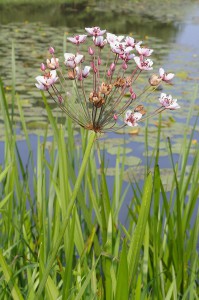 The flowering rush is a common littoral species of slack and still water bodies. The long linear triquetrous leaves of the plant are gathered into a socket around the hairless stem ending with an umbel. Blossoming stems reach up to 1.5 m in length. The rush has a strong horizontal rootstalk with branching additional roots. It blossoms from June to August.
The flowering rush is a common littoral species of slack and still water bodies. The long linear triquetrous leaves of the plant are gathered into a socket around the hairless stem ending with an umbel. Blossoming stems reach up to 1.5 m in length. The rush has a strong horizontal rootstalk with branching additional roots. It blossoms from June to August.
Apart from lake shoals, ponds and rivers, this tall and beautiful plant can be seen in swamped meadows too, where the soil remains wet all summer, with some open water in lower parts. Sometimes it grows in bigger thickets.
The plant’s inflorescence may have over twenty flowers blooming in turns. Each umbel usually has buds, open blossoms and dead flowers at the same time. The flower – large and pretty – has six leaves of the envelope. Three sepals are pale pink with thin maroon veins, and three petals are reddish green with violet. In the center of the flower, there are the bright maroon pistils and stamens. The fruit is a follicle, thus it can float on the surface of water, propagating to new spots.
The rootstalks contain starch and protein. In the old days, when thickets of this precious plant were more common, they used to grind its rootstalks to flour.
The flowering rush is a protected species!
/ * The photos at lake.peipsi.org are cross-posted from commons.wikimedia.org and are used for familiarization purposes only. No commercial use of the photos is allowed. For more information about to use the photos see the originals on commons.wikimedia.org. /


